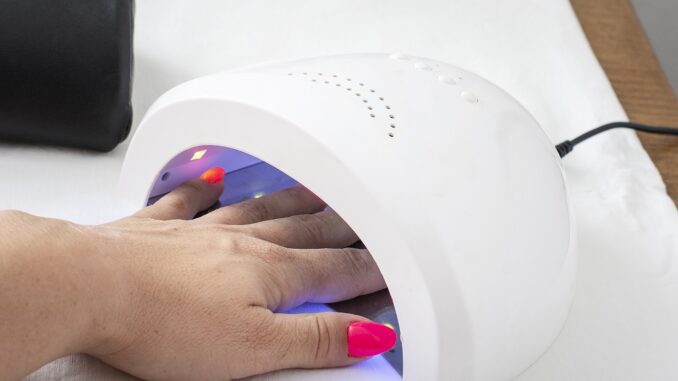
Introduction:
In the pursuit of flawless manicures, ultraviolet (UV) nail polish dryers have become a staple in many salons and households. While these devices offer the convenience of quick-drying, recent concerns have surfaced regarding potential health risks associated with their use. In this comprehensive exploration, we delve into the intricacies of UV nail polish dryers, shedding light on the science behind their functionality, examining the potential risks, and providing guidance on safe practices for both salon professionals and enthusiasts.
I. The Mechanics of UV Nail Polish Dryers:
- UV Light as a Drying Agent:
- UV nail polish dryers utilize ultraviolet light to expedite the drying process of gel-based nail polishes. This technology allows for a faster curing time compared to traditional air-drying methods.
- Types of UV Nail Polish Dryers:
- UV nail polish dryers come in two primary types: UV-A and UV-C. UV-A is the more common type used in nail salons, while UV-C is known for its germicidal properties and is not typically used in the nail industry.
- Gel Nail Polishes and UV Curing:
- Gel nail polishes contain photoinitiators that react to UV light, initiating a polymerization process. This process hardens the gel polish, creating a durable and glossy finish that lasts longer than traditional nail polish.
II. Potential Health Risks Associated with UV Nail Polish Dryers:
- UV Radiation Exposure:
- The primary concern with UV nail polish dryers is the exposure to ultraviolet radiation. Prolonged and repeated exposure to UV-A radiation has been linked to an increased risk of skin aging, DNA damage, and potential skin cancer.
- Skin Sensitivity and Allergic Reactions:
- Individuals with photosensitive skin conditions or those prone to allergic reactions may experience adverse effects. Skin sensitivity to UV radiation can manifest as redness, itching, or even the development of skin rashes.
- Eye Damage:
- Direct or prolonged exposure of the eyes to UV radiation emitted by nail dryers may pose a risk of eye damage. This includes potential damage to the cornea, lens, and conjunctiva, which could lead to conditions like cataracts.
- Dermatological Concerns:
- Skin around the nails, especially the cuticle area, is delicate. Excessive exposure to UV radiation may contribute to the development of premature aging, including wrinkles and pigmentation changes.
III. Research Findings on UV Nail Dryer Safety:
- Studies on UV-A Exposure:
- Scientific studies have explored the impact of UV-A exposure from nail polish dryers on skin health. Research indicates that the risk of skin cancer is generally low but may be influenced by factors such as duration and frequency of exposure.
- Occupational Exposure in Salons:
- Salon professionals who use UV nail polish dryers regularly may be at an increased risk of cumulative UV exposure. Occupational safety measures and guidelines are crucial to protect the health of salon workers.
IV. Safety Guidelines for UV Nail Polish Dryer Use:
- Limiting Exposure Time:
- To minimize the risk of UV exposure, it is advisable to limit the time spent under the UV nail polish dryer. Following manufacturer-recommended curing times and avoiding unnecessary prolonged exposure is essential.
- Using Sunscreen or UV Shields:
- Applying broad-spectrum sunscreen to the hands and surrounding skin before using a UV nail dryer can provide an additional layer of protection. Some salons also offer UV shields or fingerless gloves for clients.
- Protecting the Eyes:
- Wearing protective eyewear, such as UV-blocking goggles, shields the eyes from potential harm during UV nail drying sessions. This precaution is particularly important for salon professionals who may have frequent exposure.
- Regular Skin Checks:
- Individuals who use UV nail polish dryers regularly should be vigilant about monitoring their skin for any changes. Regular skin checks can help identify early signs of damage or sensitivity.
- Seeking Professional Advice:
- Individuals with a history of skin conditions, allergies, or concerns about UV exposure should consult with a dermatologist. Professional guidance can help assess individual risk factors and provide personalized recommendations.
V. Alternatives and Innovations:
- LED Nail Dryers:
- LED (light-emitting diode) nail dryers have gained popularity as an alternative to UV nail dryers. They use a different type of light that cures gel polish more efficiently while emitting less UV radiation.
- Air-Drying Alternatives:
- Traditional air-drying methods, though slower, remain a safe option for those who prefer to avoid UV exposure altogether. Quick-dry topcoats and fast-drying nail polish formulations are also available for time-conscious individuals.
VI. Regulation and Industry Standards:
- Manufacturer Guidelines:
- Manufacturers of UV nail polish dryers often provide usage guidelines and safety recommendations. Adhering to these guidelines is crucial for ensuring the safe use of these devices.
- Salon Protocols:
- Salons should implement safety protocols, including proper ventilation, protective measures for clients and professionals, and regular maintenance of UV nail polish dryers. Training salon staff on safety practices is essential.
VII. Public Awareness and Education:
- Informing Consumers:
- Raising awareness among consumers about the potential risks associated with UV nail polish dryers is essential. Providing information on safe usage practices empowers individuals to make informed choices.
- Professional Training:
- Salon professionals should undergo training on the safe use of UV nail polish dryers, recognizing potential risks, and implementing best practices to protect both clients and themselves.
VIII. Conclusion: Balancing Beauty and Safety
In conclusion, while UV nail polish dryers offer a convenient solution for achieving a flawless manicure, it is crucial to be aware of potential health risks associated with their use. By adopting safety measures, exploring alternative drying methods, and staying informed about industry standards, individuals can strike a balance between achieving beautiful nails and prioritizing their health. Public awareness, professional education, and ongoing research play pivotal roles in ensuring that the beauty industry continues to evolve in a manner that prioritizes the well-being of both clients and salon professionals. As the nail care landscape advances, the emphasis on safety and informed choices becomes an integral part of the quest for beautiful, healthy nails.